Page 369 of 440
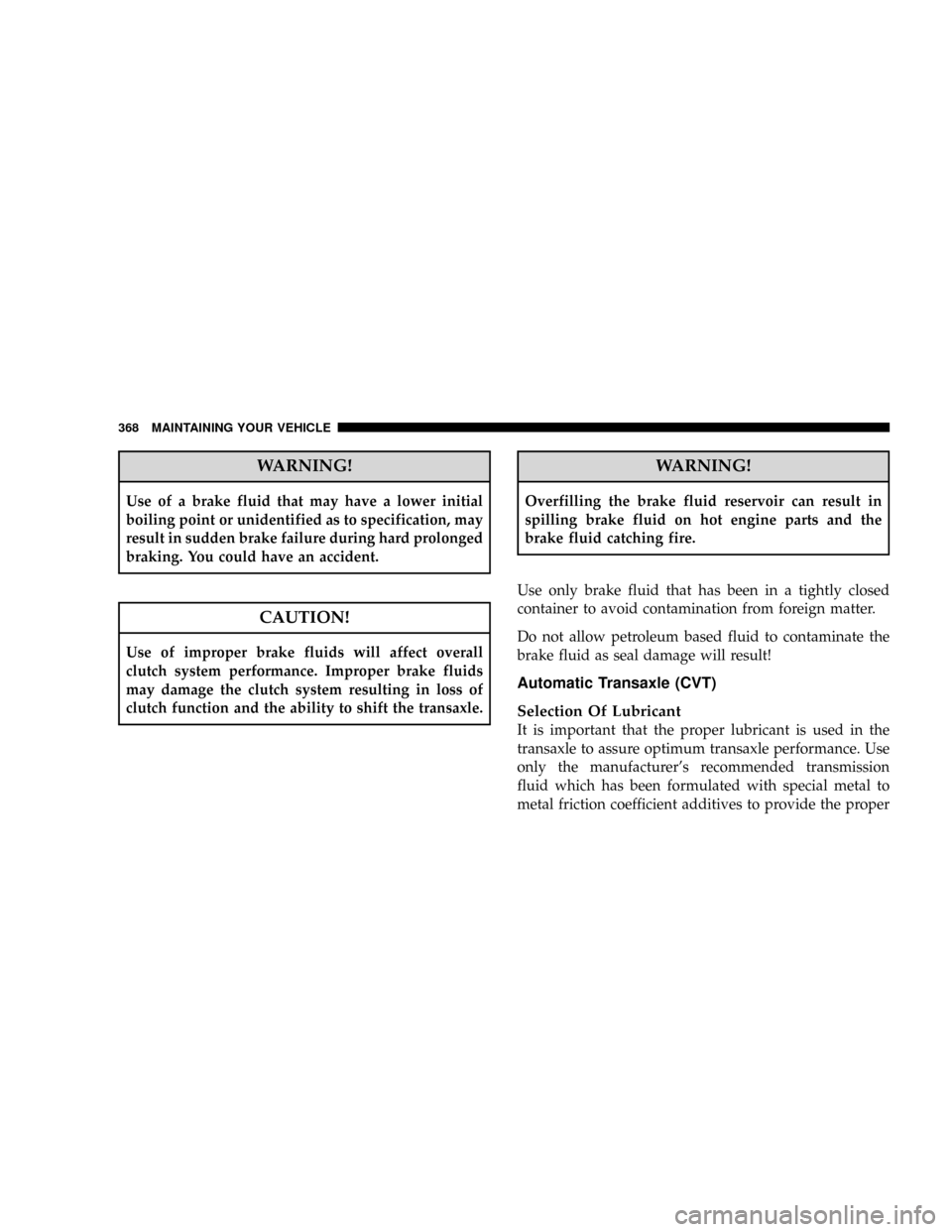
WARNING!
Use of a brake fluid that may have a lower initial
boiling point or unidentified as to specification, may
result in sudden brake failure during hard prolonged
braking. You could have an accident.
CAUTION!
Use of improper brake fluids will affect overall
clutch system performance. Improper brake fluids
may damage the clutch system resulting in loss of
clutch function and the ability to shift the transaxle.
WARNING!
Overfilling the brake fluid reservoir can result in
spilling brake fluid on hot engine parts and the
brake fluid catching fire.
Use only brake fluid that has been in a tightly closed
container to avoid contamination from foreign matter.
Do not allow petroleum based fluid to contaminate the
brake fluid as seal damage will result!
Automatic Transaxle (CVT)
Selection Of Lubricant
It is important that the proper lubricant is used in the
transaxle to assure optimum transaxle performance. Use
only the manufacturer's recommended transmission
fluid which has been formulated with special metal to
metal friction coefficient additives to provide the proper
368 MAINTAINING YOUR VEHICLE
Page 376 of 440
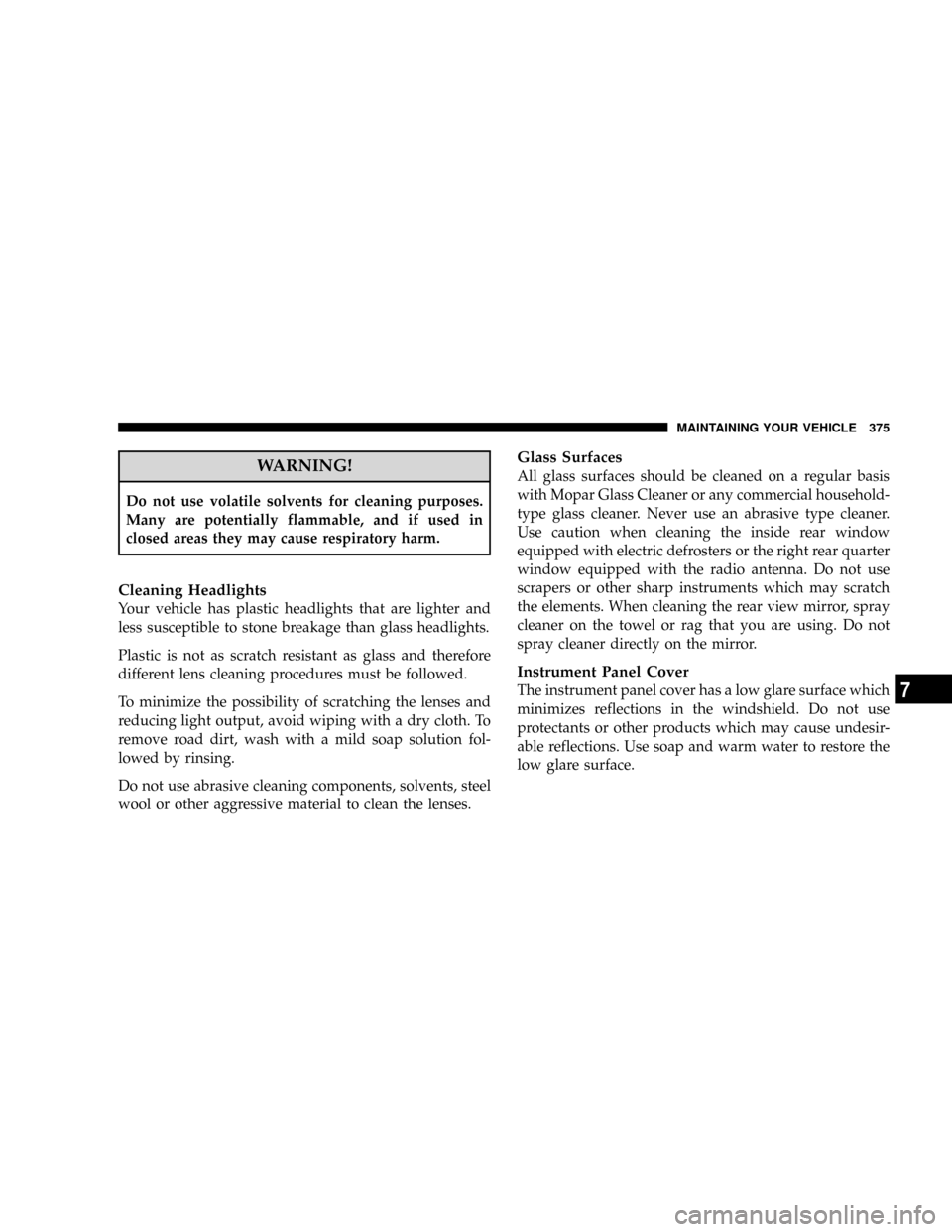
WARNING!
Do not use volatile solvents for cleaning purposes.
Many are potentially flammable, and if used in
closed areas they may cause respiratory harm.
Cleaning Headlights
Your vehicle has plastic headlights that are lighter and
less susceptible to stone breakage than glass headlights.
Plastic is not as scratch resistant as glass and therefore
different lens cleaning procedures must be followed.
To minimize the possibility of scratching the lenses and
reducing light output, avoid wiping with a dry cloth. To
remove road dirt, wash with a mild soap solution fol-
lowed by rinsing.
Do not use abrasive cleaning components, solvents, steel
wool or other aggressive material to clean the lenses.
Glass Surfaces
All glass surfaces should be cleaned on a regular basis
with Mopar Glass Cleaner or any commercial household-
type glass cleaner. Never use an abrasive type cleaner.
Use caution when cleaning the inside rear window
equipped with electric defrosters or the right rear quarter
window equipped with the radio antenna. Do not use
scrapers or other sharp instruments which may scratch
the elements. When cleaning the rear view mirror, spray
cleaner on the towel or rag that you are using. Do not
spray cleaner directly on the mirror.
Instrument Panel Cover
The instrument panel cover has a low glare surface which
minimizes reflections in the windshield. Do not use
protectants or other products which may cause undesir-
able reflections. Use soap and warm water to restore the
low glare surface.
MAINTAINING YOUR VEHICLE 375
7
Page 410 of 440
** This maintenance is recommended by the manufac-
turer to the owner, but not required to maintain the
emissions warranty.
Inspection and service should also be performed anytime
a malfunction is observed or suspected. Retain all re-
ceipts.WARNING!
You can be badly injured working on or around a
motor vehicle. Do only that service work for which
you have the knowledge and the right equipment. If
you have any doubt about your ability to perform a
service job, take your vehicle to a competent
mechanic.
SCHEDULE ªAº 409
8
M
A
I
N
T
E
N
A
N
C
E
S
C
H
E
D
U
L
E
S
Page 416 of 440
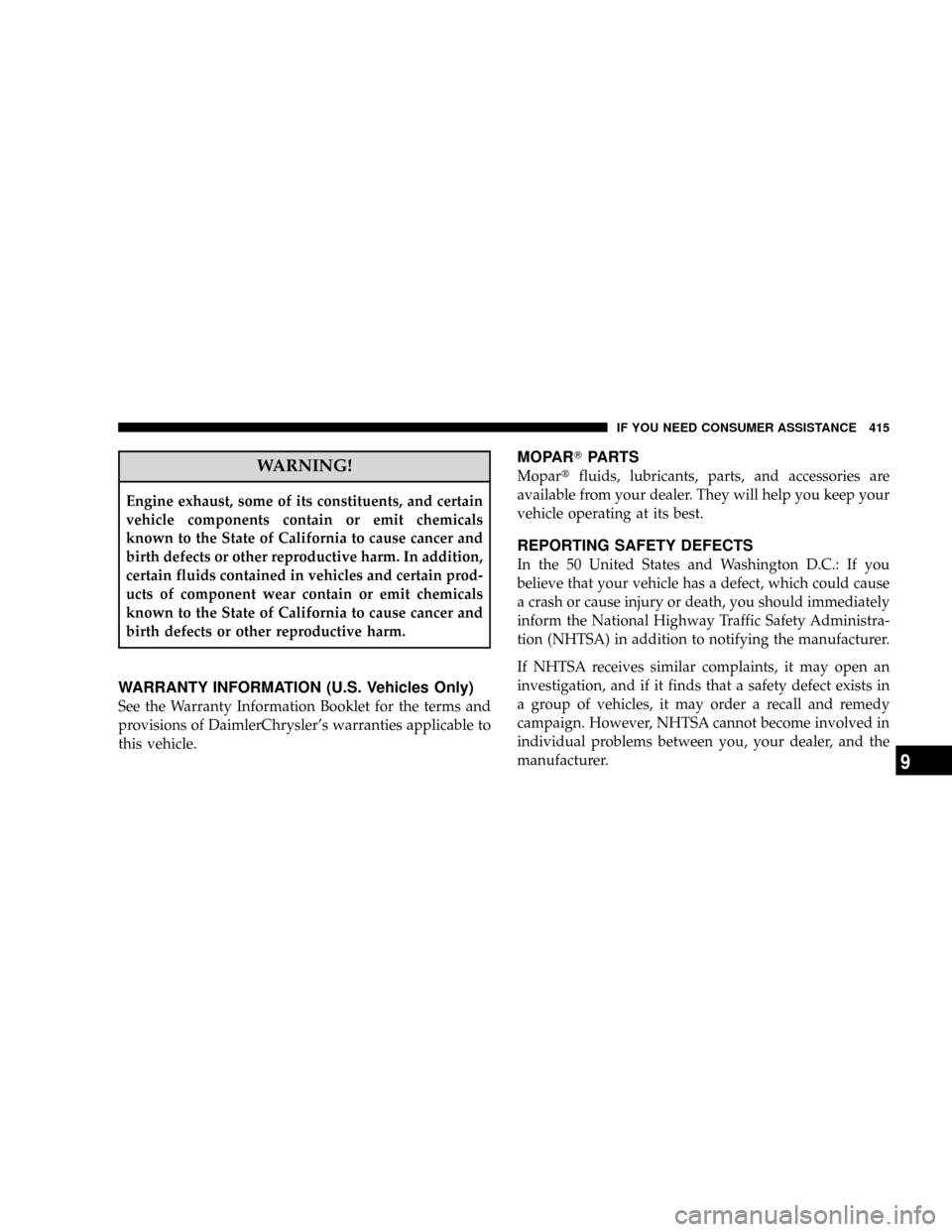
WARNING!
Engine exhaust, some of its constituents, and certain
vehicle components contain or emit chemicals
known to the State of California to cause cancer and
birth defects or other reproductive harm. In addition,
certain fluids contained in vehicles and certain prod-
ucts of component wear contain or emit chemicals
known to the State of California to cause cancer and
birth defects or other reproductive harm.
WARRANTY INFORMATION (U.S. Vehicles Only)
See the Warranty Information Booklet for the terms and
provisions of DaimlerChrysler's warranties applicable to
this vehicle.
MOPARTPARTS
Mopartfluids, lubricants, parts, and accessories are
available from your dealer. They will help you keep your
vehicle operating at its best.
REPORTING SAFETY DEFECTS
In the 50 United States and Washington D.C.: If you
believe that your vehicle has a defect, which could cause
a crash or cause injury or death, you should immediately
inform the National Highway Traffic Safety Administra-
tion (NHTSA) in addition to notifying the manufacturer.
If NHTSA receives similar complaints, it may open an
investigation, and if it finds that a safety defect exists in
a group of vehicles, it may order a recall and remedy
campaign. However, NHTSA cannot become involved in
individual problems between you, your dealer, and the
manufacturer.
IF YOU NEED CONSUMER ASSISTANCE 415
9
Page 419 of 440
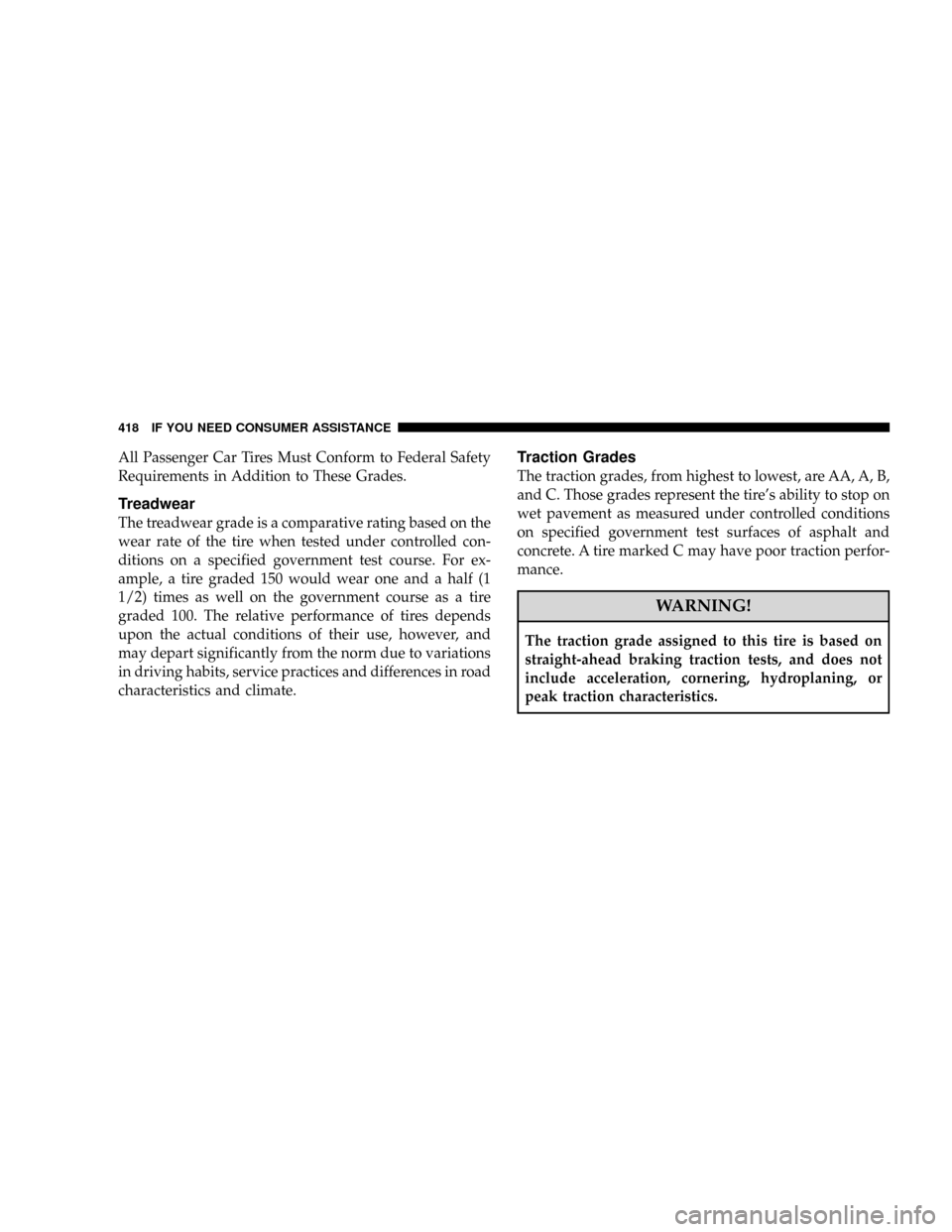
All Passenger Car Tires Must Conform to Federal Safety
Requirements in Addition to These Grades.
Treadwear
The treadwear grade is a comparative rating based on the
wear rate of the tire when tested under controlled con-
ditions on a specified government test course. For ex-
ample, a tire graded 150 would wear one and a half (1
1/2) times as well on the government course as a tire
graded 100. The relative performance of tires depends
upon the actual conditions of their use, however, and
may depart significantly from the norm due to variations
in driving habits, service practices and differences in road
characteristics and climate.
Traction Grades
The traction grades, from highest to lowest, are AA, A, B,
and C. Those grades represent the tire's ability to stop on
wet pavement as measured under controlled conditions
on specified government test surfaces of asphalt and
concrete. A tire marked C may have poor traction perfor-
mance.
WARNING!
The traction grade assigned to this tire is based on
straight-ahead braking traction tests, and does not
include acceleration, cornering, hydroplaning, or
peak traction characteristics.
418 IF YOU NEED CONSUMER ASSISTANCE
Page 420 of 440
Temperature Grades
The temperature grades are A (the highest), B, and C,
representing the tire's resistance to the generation of heat
and its ability to dissipate heat when tested under
controlled conditions on a specified indoor laboratory
test wheel. Sustained high temperature can cause the
material of the tire to degenerate and reduce tire life, and
excessive temperature can lead to sudden tire failure. The
grade C corresponds to a level of performance which all
passenger car tires must meet under the Federal Motor
Vehicle Safety Standard No. 109. Grades B and A repre-
sent higher levels of performance on the laboratory test
wheel than the minimum required by law.WARNING!
The temperature grade for this tire is established for
a tire that is properly inflated and not overloaded.
Excessive speed, under inflation, or excessive load-
ing, either separately or in combination, can cause
heat buildup and possible tire failure.
IF YOU NEED CONSUMER ASSISTANCE 419
9
Page 424 of 440
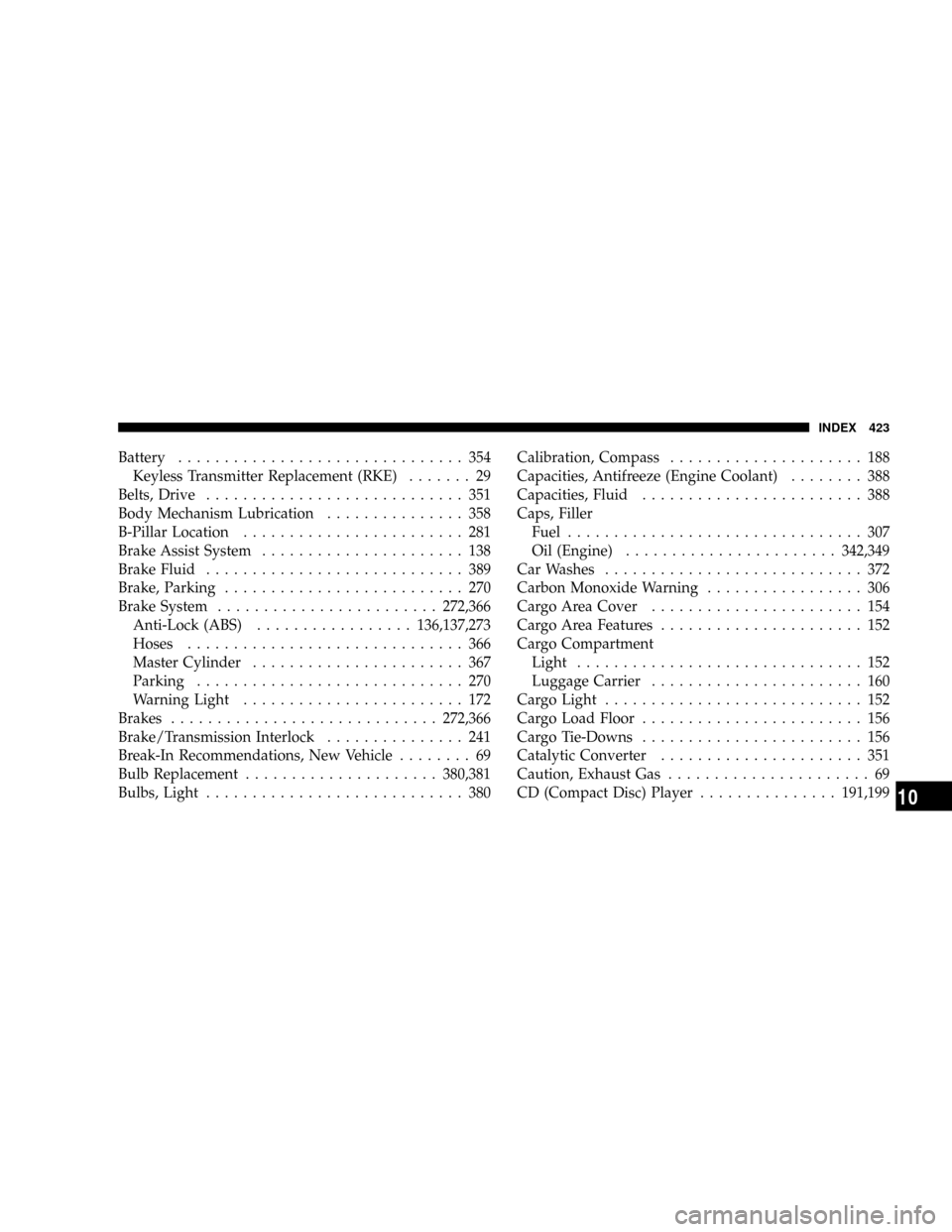
Battery............................... 354
Keyless Transmitter Replacement (RKE)....... 29
Belts, Drive............................ 351
Body Mechanism Lubrication............... 358
B-Pillar Location........................ 281
Brake Assist System...................... 138
Brake Fluid............................ 389
Brake, Parking.......................... 270
Brake System........................272,366
Anti-Lock (ABS).................136,137,273
Hoses.............................. 366
Master Cylinder....................... 367
Parking............................. 270
Warning Light........................ 172
Brakes.............................272,366
Brake/Transmission Interlock............... 241
Break-In Recommendations, New Vehicle........ 69
Bulb Replacement.....................380,381
Bulbs, Light............................ 380Calibration, Compass..................... 188
Capacities, Antifreeze (Engine Coolant)........ 388
Capacities, Fluid........................ 388
Caps, Filler
Fuel................................ 307
Oil (Engine).......................342,349
Car Washes............................ 372
Carbon Monoxide Warning................. 306
Cargo Area Cover....................... 154
Cargo Area Features...................... 152
Cargo Compartment
Light............................... 152
Luggage Carrier....................... 160
Cargo Light............................ 152
Cargo Load Floor........................ 156
Cargo Tie-Downs........................ 156
Catalytic Converter...................... 351
Caution, Exhaust Gas...................... 69
CD (Compact Disc) Player...............191,199
INDEX 423
10
Page 427 of 440
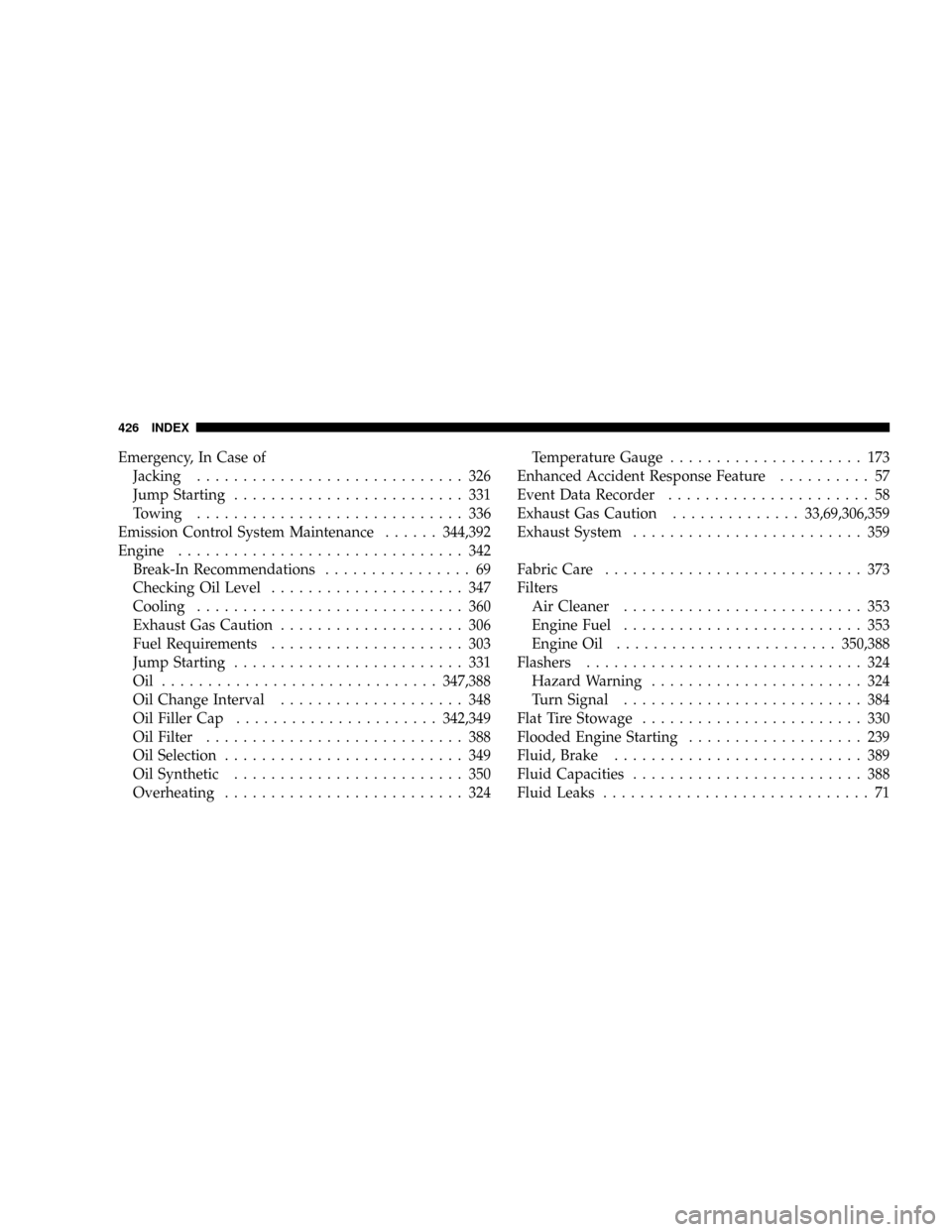
Emergency, In Case of
Jacking............................. 326
Jump Starting......................... 331
Towing............................. 336
Emission Control System Maintenance......344,392
Engine............................... 342
Break-In Recommendations................ 69
Checking Oil Level..................... 347
Cooling............................. 360
Exhaust Gas Caution.................... 306
Fuel Requirements..................... 303
Jump Starting......................... 331
Oil ..............................347,388
Oil Change Interval.................... 348
Oil Filler Cap......................342,349
Oil Filter............................ 388
Oil Selection.......................... 349
Oil Synthetic......................... 350
Overheating.......................... 324Temperature Gauge..................... 173
Enhanced Accident Response Feature.......... 57
Event Data Recorder...................... 58
Exhaust Gas Caution..............33,69,306,359
Exhaust System......................... 359
Fabric Care............................ 373
Filters
Air Cleaner.......................... 353
Engine Fuel.......................... 353
Engine Oil........................350,388
Flashers.............................. 324
Hazard Warning....................... 324
Turn Signal.......................... 384
Flat Tire Stowage........................ 330
Flooded Engine Starting................... 239
Fluid, Brake........................... 389
Fluid Capacities......................... 388
Fluid Leaks............................. 71
426 INDEX